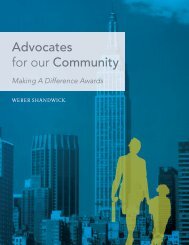White Paper - Weber Shandwick
White Paper - Weber Shandwick
White Paper - Weber Shandwick
You also want an ePaper? Increase the reach of your titles
YUMPU automatically turns print PDFs into web optimized ePapers that Google loves.
T<br />
his easy access to highly visual information and social connectivity<br />
has contributed to the expectation – however unrealistic<br />
at times – that companies develop a similarly social and informative<br />
relationship with the public.<br />
The majority of traditional news media understand this expectation<br />
already. They now present their stories in multiple formats,<br />
understanding that consumers expect a variety of options, both in<br />
where they get their news and how they absorb it. For example,<br />
any given CNN story is produced in several different mediums:<br />
a text-based story, a video, graphic images, photographs and<br />
anchor and reporter blogs and tweets.<br />
Traditional media also understand that not everyone will visit their<br />
homepage or pick up their front page. So they distribute their<br />
stories across as many platforms as possible to maximize viewership.<br />
Links to articles are likewise tweeted, or shared on Facebook. Media<br />
blogs and other aggregators post or link to stories and write about<br />
them on their own “main” news sites. Stories are reconstituted for<br />
YouTube. In short, traditional media outlets understand the need for<br />
multiple platforms and formats when it comes to getting their news<br />
absorbed. They also know they must provide a means for their audiences<br />
to talk right back, both to them and to others in the crowd.<br />
Apple summed all this up in a recent TV advertisement: “Now, we<br />
can watch a newspaper, listen to a magazine ...” In five seconds they<br />
captured the transcendence of information over format. It’s beyond<br />
text, more than a website or print publication. It’s mobile, it’s in our<br />
hands wherever we go. We can watch it, hear it, touch it, respond to<br />
it and – most critically, perhaps – share it. Never has the word multimedia<br />
taken on more meaning in our society.<br />
This change plays out as the merging of once-discrete parts of<br />
the communications industry – i.e., fusions – where the reactions<br />
change how we work with the media, our clients, our colleagues and<br />
the public.<br />
2





